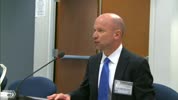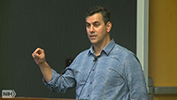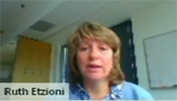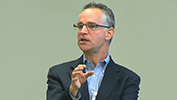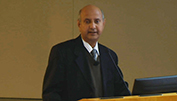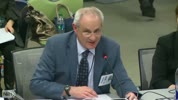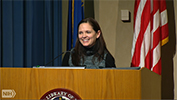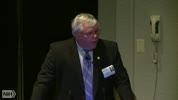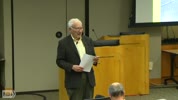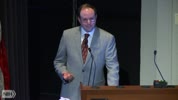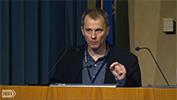-
- NIH VideoCast - Germs, genes, and host defense
-
- - Cisca Wijmenga, Ph.D., Professor of Human Genetics, Head of the Genetics Department, Department of Genetics, University Medical Center Groningen, Groningen, the Netherlands (2016/11/24)
- - Category : WALS - Wednesday Afternoon Lectures
- Wednesday Afternoon Lecture Series
The Human Functional Genomics Project (HFGP) is a large-scale project that aims to identify the consequences that genetic variation in human DNA and the complex colonization with microbial communities (microbiome) have on the physiological processes in the human body, with a special focus on the immune system in health and human diseases. HFGP includes different deeply phenotyped cohorts with multi-omics information such as transcriptional profiling, gut microbiota composition and extensive immune phenotyping.
For her lecture, Dr. Wijmenga will describe the potential of studying variation in the general population and the opportunities for translational research. She will also show how to make use of the LifeLines-deep cohort to establish what constitutes a "normal" gut microbiome and to show how microbiota composition correlates with a range of factors including diet, use of medication, and genetic factors. Her laboratory uses the 500 functional genomics (500FG) cohort to further characterize the interaction between the genetic background of the host, the gut microbiome composition, and the immune response against important human pathogens. The information from both LifeLines-deep and 500FG is subsequently used to identify genes that underlie the genetic susceptibility to systemic candida infections.
For more information go to https://oir.nih.gov/wals/2016-2017
NIH VideoCast - Germs, genes, and host defense
-
- NIH VideoCast - How to Hit HIV Where It Hurts
-
- - Arup K. Chakraborty, Ph.D., Robert T. Haslam Professor of Chemical Engineering, Physics, Chemistry, and Biological Engineering, MIT (2016/11/24)
- - Category : Immunology
- Immunology Interest Group Seminar Series
No medical procedure has saved more lives than vaccination. But, today, some pathogens have evolved which have defied successful vaccination using the empirical paradigms pioneered by Pasteur and Jenner. One characteristic of many pathogens for which successful vaccines do not exist is that they present themselves in various guises. HIV is an extreme example because of its high mutability. This highly mutable virus can evade natural or vaccine induced immune responses, often by mutating at multiple sites linked by compensatory interactions. I will first describe how by bringing to together concepts from the physical sciences with in vitro experiments and clinical data the ??itness landscape??of HIV has been defined with explicit account for collective mutational pathways, how this knowledge has been harnessed for immunogen design, and what are the current challenges. I will next describe how research at the intersection of immunology, evolutionary biology, and physics is revealing how affinity maturation occurs in the presence of multiple variant antigens, and how the results can inform the design of vaccination protocols that may be able to induce broadly neutralizing antibodies against highly mutable pathogens (e.g., HIV).
Arup K. Chakraborty is the Robert T. Haslam Professor of Chemical Engineering, Physics, Chemistry, and Biological Engineering at MIT. He is the founding Director of MIT?? Institute for Medical Engineering and Science. He is also a founding steering committee member of the Ragon Institute of MIT, MGH, and Harvard, and an Associate Member of the Broad Institute of MIT & Harvard. After obtaining his PhD in chemical engineering and postdoctoral studies, he joined the faculty at the University of California at Berkeley in December 1988. He rose through the ranks, and ultimately served as the Warren and Katherine Schlinger Distinguished Professor and Chair of Chemical Engineering, Professor of Chemistry, and Professor of Biophysics at Berkeley. He was also Head of Theoretical and Computational Biology at Lawrence Berkeley National Laboratory. In September 2005, Chakraborty moved to MIT. His entire career has been focused on research at the intersection of disciplines. After an early career in engineering of polymers and catalysts, since 2000, Chakraborty?? work has focused on bringing together immunology and the physical and engineering sciences. His interests span T cell signaling, T cell development and repertoire, and a mechanistic understanding of HIV evolution and vaccine design. Chakraborty?? work at the intersection of disciplines has been recognized by numerous honors, including the NIH Director?? Pioneer Award, the E.O. Lawrence Medal for Life Sciences from the US DOE, the Allan P. Colburn and Professional Progress awards from the AIChE, a Dreyfus Teacher-Scholar award, and a National Young investigator award. Chakraborty was elected a member of the National Academy of Sciences and the National Academy of Engineering for completely different bodies of work. He is a Fellow of the American Academy of Arts & Sciences and the American Association for the Advancement of Science, and serves on the US Defense Science Board. Chakraborty has received four teaching awards at Berkeley and MIT.
NIH VideoCast - How to Hit HIV Where It Hurts
-
- NIH VideoCast - Office of AIDS Research Advisory Council Meeting - November 2016
-
- - NIAID, NIH (2016/11/24)
- - Category : AIDS Research Advisory Committee
- The (OARAC) will be devoted to presentations and discussions on ??ESEARCH TOWARDS A CURE.??In addition, an update will be provided on the latest changes made to the HHS treatment and prevention guidelines by the OARAC Working Groups responsible for the guidelines.
NIH VideoCast - Office of AIDS Research Advisory Council Meeting - November 2016
-
- NIH VideoCast - Craniofacial Development and the Quest for Preventing Birth Defects
-
- - Paul Trainor, BSc, PhD, Stowers Institute for Medical Research (2016/11/24)
- - Category : Special
- NIDCR Clinical Research Fellowship Grand Rounds
Craniofacial abnormalities account for approximately one-third of all congenital birth defects, are a major cause of infant mortality, and dramatically impact national health care budgets. Postnatal treatment of malformation syndromes through comprehensive, well-coordinated and integrated strategies may provide satisfactory management of individual conditions, but rarely are they fully corrective. Therefore, considerable effort needs to be invested in developing prevention strategies, and this can only come from a thorough understanding of the normal events that regulate craniofacial development. The presentation will focus on recent advances in understanding the etiology and pathogenesis of Treacher Collins syndrome and emerging prospects for prevention that may have broad application to congenital craniofacial birth defects.
NIH VideoCast - Craniofacial Development and the Quest for Preventing Birth Defects
-
- NIH VideoCast - Roles of regulatory RNAs & RNA-binding proteins in (re)programming patterns of gene expression
-
- - Stefan Adi Muljo, Ph.D., Senior Investigator, Intergrative Immunobiology Unit, NIAID, NIH (2016/11/24)
- - Category : NIH Director`s Seminars
- NIH Director`s Seminar Series
The Integrative Immunobiology Section is interested in understanding how gene expression programs are orchestrated in our cells, particularly stem cells. Specifically, the laboratory studies how these systems are controlled by non-coding RNAs and RNA-binding proteins. Our major goal is to discover novel molecular circuits that control cell fates in the hematopoietic and immune systems, since perturbations in their genetic regulatory networks underlie many diseases. To address these fundamental issues, we employ an integrative systems biology approach to reverse engineer the molecular logic of cell fate determination. We combine genome- and transcriptome-wide measurements with experimental perturbations in order to test and refine our models. As one example of our success, we identified the RNA-binding protein Lin28b as a lineage-determining factor for fetal hematopoietic stem cells, a discovery with potentially important implications for Regenerative and Precision Medicine. At a basic level, we demonstrate the concept of post-transcriptional (re)programming of cell fate decisions.
NIH VideoCast - Roles of regulatory RNAs & RNA-binding proteins in (re)programming patterns of gene expression
-
- NIH VideoCast - Medicine: Mind the Gap: Overdiagnosis in Cancer Screening: Overcoming Challenges, Avoiding Mistakes
-
- - Ruth B. Etzioni, Ph.D., Chair, Scientific Steering Committee, Hutch Data Commonwealth, Division of Public Health Sciences, Fred Hutchinson Cancer Research Center (2016/11/24)
- - Category : Medicine: Mind the Gap
- Medicine: Mind the Gap Seminar
3-Part Series on Disease Prevention Screening
Series Topic #3:
Overdiagnosis in Cancer Screening: Overcoming Challenges, Avoiding Mistakes
Presented by Ruth B. Etzioni, Ph.D.
Chair, Scientific Steering Committee
Hutch Data Commonwealth
Division of Public Health Sciences
Fred Hutchinson Cancer Research Center
The problem of overdiagnosis, the detection by screening of latent cancers that would never have surfaced, has been much in the news lately. What is overdiagnosis, and how significant is the problem? In this presentation, Dr. Etzioni will examine how overdiagnosis arises and will discuss what it takes to validly estimate its frequency. Different types of study designs and estimation methods have been used, but many of these probably yield biased results. Consumers of overdiagnosis studies need to carefully navigate the published literature to properly understand the extent of the problem. Dr. Etzioni will provide a guide using examples from breast and prostate cancer screening to identify the types of studies that are most likely to produce reliable results.
Dr. Etzioni is a biostatistician and full member in the Division of Public Health Sciences at the Fred Hutchinson Cancer Research Center. Her research program focuses on the development of innovative statistical and computer models to learn about the latent process of cancer progression from observed data on disease incidence and mortality. This knowledge is applied to fill in the evidence gaps that inevitably arise when developing policies for cancer detection and management.
Dr. Etzioni will accept questions about her presentation via email at prevention@mail.nih.gov
and on Twitter with #NIHMtG.
For more information go to https://prevention.nih.gov/programs-events/medicine-mind-the-gap/seminars/defining-measuring-overdiagnosis
Please provide your feedback on the seminar evaluation survey:
NIH VideoCast - Medicine: Mind the Gap: Overdiagnosis in Cancer Screening: Overcoming Challenges, Avoiding Mistakes
-
- NIH VideoCast - The Development of Spontaneous Activity in Neonatal Mice
-
- - Michael Crair, Ph.D., William Ziegler III Professor of Neuroscience, Professor of Ophthalmology and Visual Science, Department of Neurobiology, Yale University School of Medicine (2016/11/24)
- - Category : Neuroscience
- NIH Neuroscience Series Seminar
In the brains of mammals, birds and invertebrates, the sensory world is organized into regular neuronal arrays or maps. Common examples are the map of body surface in somatosensory cortex (the so called ??omunculus?? and the representation of oriented bars or edges in visual cortex. Dr. Crair?? lab is interested in understanding how genes (??ature?? and the environment (??urture?? interact to guide the development of neuronal maps.
Their research focuses on development of the visual and somatosensory systems. They employ a broad range of experimental techniques, including neuroanatomy, molecular biology and biochemistry, in vitro and in vivo electrophysiology as well as optical imaging. This array of approaches allows them to examine neural circuit development from many perspectives, and provides synergistic impetus to their exploration of the cellular and molecular mechanisms for sensory map development.
For more information go to https://neuroscience.nih.gov/neuroseries/Home.aspx
NIH VideoCast - The Development of Spontaneous Activity in Neonatal Mice
-
- NIH VideoCast - TRACO 2016: Epigenetics and Pancreatic cancer
-
- - Mukesh Verma, Ph.D, NCI, NIH and S. Perwez Hussain, Ph.D, NCI, NIH (2016/11/24)
- - Category : TRACO
- Epigenetics and Pancreatic cancer
For more information go to http://ccr.cancer.gov/trainee-resources-courses-workshops-traco
NIH VideoCast - TRACO 2016: Epigenetics and Pancreatic cancer
-
- NIH VideoCast - Recombinant DNA Advisory Committee - March 2016 (Day 2)
-
- - OSP, NIH (2016/03/15)
- - Category : Recombinant DNA Advisory Committee
- The Recombinant DNA Advisory Committee is a federal advisory committee that provides recommendations to the NIH Director related to basic and clinical research involving recombinant or synthetic nucleic acid molecules. RAC proceedings and reports are posted to the OBA Web site to enhance their accessibility to the scientific and lay public.
NIH VideoCast - Recombinant DNA Advisory Committee - March 2016 (Day 2)
-
- NIH VideoCast - Future Historical Collections: Archiving the 2014 Ebola Outbreak
-
- - Christie Moffatt, Archivist & Manager, Digital Manuscripts Program, NLM, NIH (2016/03/15)
- - Category : History of Medicine
- History of Medicine Lecture
Christie Moffatt, MLIS, Archivist and manager of the History of Medicine Division`s Digital Manuscripts Program, will spotlight the development of the National Library of Medicine???s Ebola web archive collection, which began when the library took the initiative to capture and preserve selected born-digital web content documenting the 2014 Ebola outbreak.
For more information go to https://www.nlm.nih.gov/hmd/happening/lectures/lectures_2016.html
NIH VideoCast - Future Historical Collections: Archiving the 2014 Ebola Outbreak
-
- NIH VideoCast - Predicting the incidence of cancer: Does natural selection pick holographic networks?
-
- - Vipul Periwal, Ph.D., Senior Investigator, NIDDK, NIH (2016/03/15)
- - Category : NIH Director`s Seminars
- Director`s Seminar Series
Maintenance of function in many tissues in adult animals requires controlled somatic stem cell replication. The vast majority of these replication events are uneventful, as there are multiple levels of quality control: DNA damage repair mechanisms, paracrine signaling and the extracellular matrix, the immune system, and likely others that have not been uncovered. Our work has modeled tissue development and homeostasis processes in a variety of tissues: adipose tissue, beta cells in the islets of Langerhans, the development of the overall endocrine pancreas, and liver regeneration after partial hepatectomy. We will discuss levels at which tissue homeostasis can be modeled with large-scale data collection, and some general theoretical features of networks that dynamically can maintain homeostasis. Turning then to the other end of the spectrum of cell replication, cancer, where cells have evaded quality control, we will survey models of cancer incidence, and propose a new dynamic model that predicts population cancer incidence for all types of sporadic cancers with few parameters. This model reveals a startling simplicity in the sum total effect of the multiple levels of cellular replication quality control in all cancer types. We attempt to understand the relative contributions of different repair mechanisms by modeling skin cancer incidence in Xeroderma Pigmentosum subjects.
NIH VideoCast - Predicting the incidence of cancer: Does natural selection pick holographic networks?
-
- NIH VideoCast - PiCo Talks 2016
-
- - Office of the Director, Office of the Associate Director for Data Science, NIH (2016/03/15)
- - Category : Special
- Join the NIH Pi Day 2016 celebration with PiCo talks from NIH staff.
Opening remarks will be given by Dr. Michael Gottesman, Deputy Director for Intramural Research.
PiCo talks will be presented in the following order:
Alejandro Alvarez-Prats, NICHD: Phosphatidylinositol 4-kinase type III?? (PI4KA) is required for proper myelination of peripheral nerves in mice.
Christopher Belter, OD: Advanced citation searching for systematic reviews
Ben Busby, NCBI: NCBI and regional hackathons: Building community software for bioinformatics
Maxwell Lee, NCI: Interpreting multivariate data analysis through the lens of geometric representation
Philip McQueen, CIT: Information in neuron morphology
Thorsten Pr??stel, NIAID: Space-time approach to fast stochastic simulation algorithms
Hoo Chang Shin, Clinical Center: Interleaved text/image deep mining on a large-scale radiology image database
Parmit Kumar Singh, NICHD: LEDGF/p75 interacts with mRNA splicing factors and targets HIV-1 integration to highly spliced genes
Paul Wakim, Clinical Center: Correlation with repeated measures: what you should and should not do
Xiaosong Wang, Clinical Center: Towards large-scale radiology image database auto-annotation: a Deep Pseudo-task Learning approach
Lana Yeganova, NCBI: Hypergeometric in action!
For more information go to https://datascience.nih.gov/PiDay2016/Schedule/PiCoLightning
NIH VideoCast - PiCo Talks 2016
-
- NIH VideoCast - Ultrafast endocytosis of synaptic vesicles
-
- - Erik Jorgenson, PH.D., University of Utah (2016/03/15)
- - Category : Neuroscience
- NIH Neuroscience Series Seminar
Dr. Jorgensen laboratory studies the molecular basis of synaptic transmission, focusing on the mechanisms of synaptic vesicle fusion and synaptic strength. Other research projects include studies of neuroendocrine secretion, specifically, the modulation of behavioral states caused by changes in the environment, such as the presence of food or mates. Another goal is to understand the neuronal circuits that give rise to behaviors, particularly the generation of rhythmic behavior. Other research groups in the laboratory are studying transposons in the worm, as well as double-strand break repair of DNA.
NIH VideoCast - Ultrafast endocytosis of synaptic vesicles
-
- NIH VideoCast - Principles of Clinical Pharmacology ~ Drug Discovery
-
- - Dr. Edward Sausville (2016/03/13)
- - Category : Principles of Clinical Pharmacology
- The "Principles of Clinical Pharmacology" course is a weekly lecture series covering the fundamentals of clinical pharmacology as a translational scientific discipline focused on rational drug development and utilization in therapeutics. The course is offered annually at the NIH Clinical Center and runs from September through April.
NIH VideoCast - Principles of Clinical Pharmacology ~ Drug Discovery
-
- NIH VideoCast - Demystifying Medicine 2016: Depression: Neuromodulation Meets Super-Resolution Cell Biology
-
- - Sarah Lisanby, MD, NIMH, NIH and Justin Taraska, PhD, NHLBI, NIH (2016/03/12)
- - Category : Demystifying Medicine
- Demystifying Medicine is an annual course from January to May designed to help bridge the gap between advances in biology and their application to major human diseases. The course includes presentation of patients, pathology, diagnosis, and therapy in the context of major disease problems and current research, primarily directed toward Ph.D. students, fellows, and staff. All are invited.
For more information go to https://demystifyingmedicine.od.nih.gov/
NIH VideoCast - Demystifying Medicine 2016: Depression: Neuromodulation Meets Super-Resolution Cell Biology
-
- NIH VideoCast - Introduction to the Principles and Practice of Clinical Research (IPPCR): Technology Transfer
-
- - Bruce Goldstein, J.D. (2016/03/12)
- - Category : IPPCR
- The Introduction to the Principles and Practice of Clinical Research (IPPCR) is a course to train participants on how to effectively conduct clinical research. The course focuses on the spectrum of clinical research and the research process by highlighting epidemiologic methods, study design, protocol preparation, patient monitoring, quality assurance, and Food and Drug Administration (FDA) issues.
For more information go to http://clinicalcenter.nih.gov/training/training/ippcr1.html
NIH VideoCast - Introduction to the Principles and Practice of Clinical Research (IPPCR): Technology Transfer
-
- NIH VideoCast - Inferring Host-Pathogen Interactions from Diverse Data Sources
-
- - Mark Craven, Ph.D., Department of Biostatistics and Medical Informatics, University of Wisconsin (2016/03/12)
- - Category : Special
- National Library of Medicine Informatics Lecture Series
Insight into the mechanisms and context of host-pathogen interactions can be gained by applying computational methods to a broad range of experimental, observational, and secondary data sources. Dr. Craven will discuss his work in three studies that involve developing and applying predictive methods in order to characterize host-pathogen interactions. In the first study, he is focused on inferring host subnetworks that are involved in viral replication from genome-wide loss-of-function experiments. Although these experiments can identify the host factors that directly or indirectly facilitate or inhibit the replication of a virus in a host cell, they do not elucidate how these genes are organized into the biological pathways that mediate host-virus interactions. His team is developing novel computational methods that use a wide array of secondary data sources, including the scientific literature, to transform the measurements from these assays into hypotheses that predict the pathways in the cell that relate implicated genes to viral replication. In the second study, he is applying machine-learning methods to understand how variation in the genome of HSV-1 influences multiple ocular disease phenotypes in a host. In the third study, he is investigating the extent to which risk for various infectious disease phenotypes can be predicted from electronic health records.
NIH VideoCast - Inferring Host-Pathogen Interactions from Diverse Data Sources
-
- NIH VideoCast - NCI Clinical Trials and Translational Research Advisory Committee (CTAC) - March 2016
-
- - Coordinating Center for Clinical Trials (CCCT), NCI, NIH (2016/03/11)
- - Category : Clinical Trials and Translational Research
- The CTAC makes recommendations on the NCI-supported national clinical trials enterprise to build a strong scientific infrastructure by bringing together a broadly developed and engaged coalition of stakeholders involved in the clinical trial process.
For more information go to http://deainfo.nci.nih.gov/advisory/ctac/ctacmeetings.htm
NIH VideoCast - NCI Clinical Trials and Translational Research Advisory Committee (CTAC) - March 2016
-
- NIH VideoCast - Great Teachers: Career Development: Joys of Discovery
-
- - Emma A. Meagher, MD Senior Associate Dean for Clinical Research, Perelman School of Medicine and Associate Vice Provost for Human Subjects Research, University of Pennsylvania, Philadelphia (2016/03/11)
- - Category : Clinical Center Grand Rounds
- Great Teachers: Career Development: Joys of Discovery
For more information go to http://www.cc.nih.gov/about/news/grcurrent.html
NIH VideoCast - Great Teachers: Career Development: Joys of Discovery
-
- NIH VideoCast - High times for drugs: Epigenetic imprint, legacy and brain
-
- - Yasmin Hurd, Ph.D., Professor of Neuroscience, of Psychiatry, and of Pharmacology and Systems Therapeutics; Ward-Coleman Chair of Translational Neuroscience at the Icahn School of Medicine at Mount Sinai; Director, Center for Addictive Disorders at Mount Sinai Behavioral Health System (2016/03/11)
- - Category : WALS - Wednesday Afternoon Lectures
- Wednesday Afternoon Lecture Series
Two drugs with significant impact on our society today are heroin and cannabis, both of are central focus to the research pursued by Dr. Hurd. Her talk will provide insights about the molecular neurobiological underpinnings of addiction relevant to these drugs. Her work is based on the direct study of the human brain and complementary animal models that allow the possibility to track the protracted effects of early developmental drug exposure into adulthood and even across generations on discrete neuronal systems and behavior. Her multidisciplinary translational approaches integrate molecular, epigenetic, genetic, and in vivo neuroimaging.
For more information go to https://oir.nih.gov/wals/2015-2016/high-times-drugs-epigenetic-imprint-legacy-brain
NIH VideoCast - High times for drugs: Epigenetic imprint, legacy and brain





